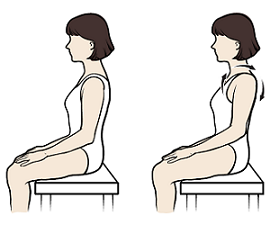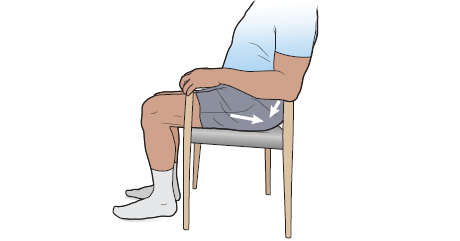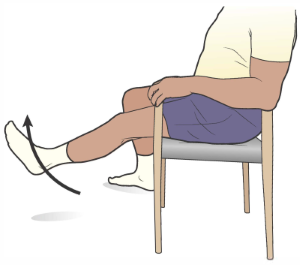This information describes exercises you can do to help manage lymphedema (swelling) in your legs, lower body, or both.
Exercises that help manage lymphedema are called decongestive (DEE-kun-JEH-stiv) exercises. They’re an important part of managing lymphedema. They help move lymph fluid around your body. They may also help you move better.
Talk with your healthcare provider before you start to do these exercises. They may change how often you do the exercises or how many times you repeat them. They may also change how you do some of the exercises. Follow their instructions.
With any exercise program, it’s important to build up slowly over time. Start out doing fewer reps and holding for less time. Work up to doing more reps and holding for longer. This lets your muscles get used to the exercises.
General instructions
- Do the exercises in the order they’re listed in this resource.
- Repeat each exercise 10 times, if you can. It’s helpful to count each repetition (rep) out loud.
- Do these exercises twice a day.
It’s best to do all the exercises in this resource. But if you have limited time, you can choose to do either the sitting exercises or standing exercises.
What to do before doing these exercises
- Dress comfortably. Your clothes should not limit your movements.
- If you have bandages or compression garments, wear them when you exercise.
What to do while doing these exercises
- Do not hold your breath. Counting each rep out loud can help.
- Only move as far as you can without feeling pain. Talk with your healthcare provider if you have questions about how to do any of the exercises.
-
You can do some of these exercises while lying down, sitting, or standing. It’s most important to do them in a comfortable position while keeping good posture. Here are some suggestions for good posture:
- Look forward with your chin tucked slightly.
- If you’re sitting, choose a supportive chair. Sit up straight with your feet flat on the ground. Keep your knees in line with your ankles and your shoulders in line with your hips.
- If you’re standing, keep your hips, knees, and ankles in line with your shoulders. Keep your feet flat on the ground.
Deep breathing exercise
It’s easiest to do this exercise lying on your back. You can also do it while sitting or standing.
- Place one or both of your hands over your abdomen (belly).
-
Breathe in slowly and deeply through your nose. Your abdomen should rise (see Figure 1), but your upper chest should stay still and relaxed.

Figure 1. Breathe in so your abdomen rises - Breathe out slowly through pursed lips, like you’re blowing out candles. As you breathe out, slowly and gently pull your abdomen towards your spine.
Repeat 10 times.
Backward shoulder rolls
- Start with your arms relaxed at your sides.
-
In a circular motion, bring your shoulders forward, up, backward, and down (see Figure 2). Try to make the circle as big as you can and move both shoulders at the same time.

Figure 2. Moving your shoulder in a circle
Repeat 10 times.
If you have some tightness across your chest, start with smaller circles. Make them bigger as your muscles get looser.
Sitting exercises
Seated march
- Sit in a chair with armrests. Place your arms on the armrests and your feet flat on the floor.
-
Slowly raise one knee without leaning back (see Figure 3). Hold the armrests to keep from leaning back.

Figure 3. Raising yor knee - Lower your leg and place your foot back on the floor.
- Repeat with your other leg.
Repeat 10 times with each leg.
Buttock squeeze
- Sit in a chair with armrests. Place your arms on the armrests and your feet flat on the floor. Make sure to sit up straight.
-
Squeeze your buttocks (butt muscles) together tightly for 3 seconds (see Figure 4). It’s best to count out loud.

Figure 4. Squeezing your buttocks - Relax your buttocks.
Repeat 10 times.
Alternating knee extension
- Sit in a chair. Place your feet flat on the floor.
- Straighten one leg as far as you can. Hold for a count of one (see Figure 5).
-

Figure 5. Straighten your leg
- Place your foot back on the floor.
- Repeat with your other leg.
Repeat 10 times with each leg.
Heel/toe raises
You can do this exercise with both feet at the same time. If you choose do it with one foot at a time, make sure to do 10 reps with each foot.
- Sit in a chair with your feet flat on the floor.
- Flex your toes up toward your nose while keeping your heels on the floor (see Figure 6, left). Then, relax your feet.
- Point your toes down toward the floor and try to lift your heels off the floor (see Figure 7, right). Then, relax your feet.

Repeat 10 times. If you do this exercise with 1 foot at a time, repeat 10 times with each foot.
Ankle circles
- Lie on your back or sit up in bed or a chair.
-
Rotate one ankle clockwise (to the right) 10 times (see Figure 8).

Figure 8. Rotating your ankle - Switch directions and rotate the ankle counter-clockwise (to the left) 10 times.
- Repeat with your other ankle.
Standing exercises
While you do these exercises, hold onto a stable surface for balance. At home and in the hospital, you could use a countertop, tabletop, or stable chair. In the hospital, you could also use a locked bed rail or handrail in the hallway.
Mini squats
- Stand 6 to 12 inches (15 to 30 centimeters) away from the stable surface. Move your feet so they’re shoulder-width apart.
-
Slowly bend your hips and knees until your knees are at about a 45-degree angle (see Figure 9). Keep your back straight.

Figure 9. Bending your hips and knees - Slowly straighten your hips and knees while squeezing your buttock and front thigh muscles until you’re standing upright.
Repeat 10 times.
Standing side kicks
Stand up straight when doing this exercise. Do not lean to the side or forward.
-
Lift one leg to the side while keeping your toe pointed forward (see Figure 10).

Figure 10. Lifting your leg to the side - Hold for 5 seconds, then return to the starting position.
Repeat 10 times. Then, do the exercise again with your other leg.
Standing hamstring curls
-
Bend your knee, bringing your heel toward your buttocks. Keep your knees even with each other (see Figure 11). Stand tall and don’t bend your hips.

Figure 11. Bending your knee - Lower your foot back down to the floor.
Repeat 10 times. Then, do the exercise again with your other leg.
Heel raises
- Move your feet so they’re about 6 inches (15 centimeters) apart.
-
Slowly push up onto your toes, lifting your heels off the floor (see Figure 12).

Figure 12. Lifting your heels - Slowly lower your heels back down to the floor.
Repeat 10 times.
Deep breathing exercise
You may want to end your exercise session with another 5 reps of the deep breathing exercise.
Support services
We encourage you to keep doing all the activities you enjoy. Talk with your healthcare provider or lymphedema therapist if you have questions about your daily activities or lymphedema. The support services below may also be helpful.
American Cancer Society (ACS)
www.cancer.org
800-227-2345
The ACS shares information about lymphedema diagnosis and treatment
Lymphatic Education & Research Network (LE&RN)
www.lymphaticnetwork.org
516-625-9675
The LE&RN shares information about lymphedema diagnosis and treatment as well as resources and educational materials.
National Cancer Institute (NCI)
www.cancer.gov
800-4-CANCER (800-422-6237)
The NCI shares information about lymphedema diagnosis and treatment.
National Lymphedema Network
www.lymphnet.org
415-908-3681
The National Lymphedema Network shares information about lymphedema diagnosis and treatment, as well as resources and educational materials.
Step Up, Speak Out
www.stepup-speakout.org
Step Up, Speak Out shares resources and educational materials about lymphedema.